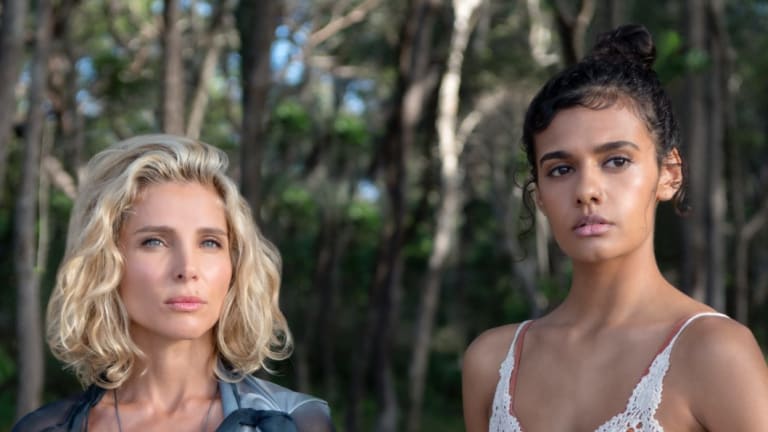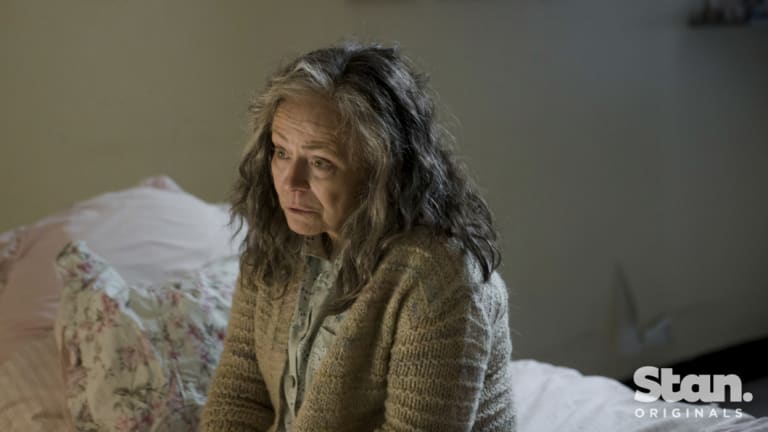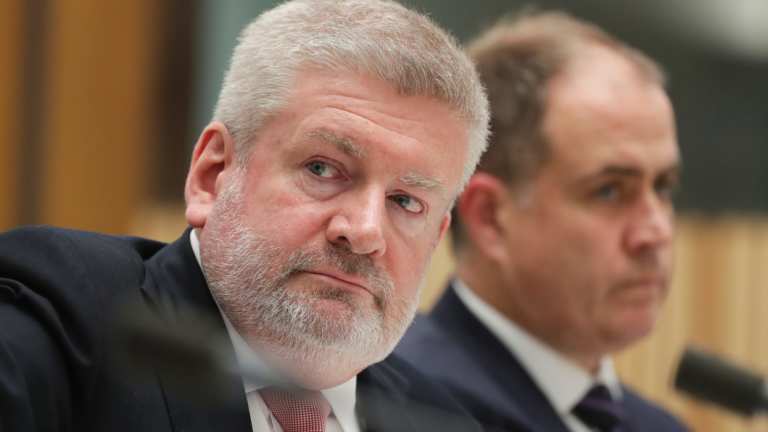
To be fair, Netflix has also co-funded or bought a number of series that have been developed by traditional broadcasters, including the ABC (Pine Gap, Glitch) and Seven (Beat Bugs), and it has bought a small number of Australian-made movies (Berlin Syndrome, Cargo). But so far, it appears its interest in Australian content is fleeting at best.
Research conducted by RMIT's Dr Ramon Lobato and released in October found Netflix had just 82 Australian titles in its local library, roughly 1.6 per cent of the total. Stan*, which has a much smaller library, had 172 Australian titles, or just over 11 per cent of the total.

Elsa Pataky and Madeleine Madden in Tidelands>. Credit:Jasin Boland/Netflix
That's not to say Stan is exactly blazing a trail either. As chief content officer Nick Forward told a recent gathering of film and television producers, the streaming service is "currently launching four to five Australian series per year, and that feels about right".
In other words, Stan is not looking to significantly expand local production in the near future (it is, however, far more committed to developing local content, not all of which will make it to screen; Netflix's preferred approach appears to be to buy content that someone else has funded through development).
This all matters because the streamers are taking eyeballs away from free-to-air and cable television, where there is a requirement to screen Australian drama, documentary and children's content. But the streamers face no such obligations at all.
Loading
"You guys keep making great content so we're going to keep buying it," Lauren Smith, Netflix's director of acquisitions for the Asia-Pacific region, told that same gathering last month. "No one told us we had to buy any of this. We've done it because it's fantastic content that we think is going to bring joy here and around the world."
The elephant in the room was quotas.
Local producers want the streaming services to be obliged to produce local content, just as the traditional commercial broadcasters are. This might be via a set percentage, as per the European Union (which recently decreed 30 per cent of content available on streaming services must originate from within the EU's 28 member states).
It could be via a content fund, perhaps based on a percentage of local revenue (as applies to Foxtel). Or it could be a simple commitment to spend a certain amount on local commissions over a set period, as per Netflix's 2017 undertaking to spend $500 million over five years on local content in Canada.
None of this will happen, though, unless the government demands it. Left to their own devices, the streaming services will quite reasonably take the simplest and most profitable path open to them.
You might imagine the traditional broadcasters might be eager for some sort of regulation of these new kids on the block, but in fact their favoured change is in the opposite direction – deregulation for all.

Jacki Weaver as Gwen Reed in Bloom, coming from Stan in January.Credit:Stan
The networks are desperate to wriggle out of their obligations to produce stipulated hours of scripted (drama and comedy), children's and documentary content. Kids' TV they'd like to see moved to the ABC entirely. Documentary they'd rather do on an ad-hoc basis, if at all. And drama and comedy – well, clearly they are better suited to streaming platforms, where viewers can binge an entire season in one or two ad-free sessions.
That's why in the clamour to impose quotas on the streaming players and web services the TV networks have been largely silent. Rather than level the playing field, they'd rather the site were razed and redeveloped entirely.
Loading
Nine, which now owns 100 per cent of Stan since the takeover of Fairfax Media (The Age owners) was finalised last week, would probably be delighted if all its scripted content were on Stan, which has 1.2 million fully paid-up subscribers and another 1.6 million floating subs (those who come in and out of the service). A little more unique content, of quality high enough that people are willing to pay for it, would likely drive subscriptions higher.
At the same time, moving scripted content off FTA would leave those channels free for the sort of cheap-to-produce, product-placement-friendly, high-rating content that drives profits – reality TV, live sport, infotainment and the like.
Something, surely, has to give. But what?
For more than a year, federal communications minister Mitch Fifield has been sitting on a major review of the Australian screen sector conducted by his own department. Last month, the Senate passed a motion to compel him to release the report, claiming refusal to do so was "hampering public debate on policy options and causing uncertainty for the screen production … sector in Australia".
He declined, citing confidentiality concerns.
"The release of this document at this time would harm the public interest in that it would interfere with the proper consideration by and deliberative process of Cabinet," Senator Fifield wrote.

Minister for Communications and the Arts Mitch Fifield has been sitting on a crucial review of the screen sector for more than a year.Credit:Alex Ellinghausen / Fairfax Media
It's clear the film and television production sector is nearing crisis point in this country. The drift away from broadcast television and towards streaming services for the consumption of drama and comedy seems inexorable. The business model that has supported that content on FTA is no longer viable, but the regulatory framework to support local content on these emerging services is nowhere to be seen.
Meanwhile, Australia continues to make a significant number of feature films – 39 in 2017, according to Screen Australia – that are required as a condition of their funding to play in cinemas, even though most are unlikely to find an audience there (because of a variety of factors besides inherent quality, including scarcity of screens and a paucity of marketing and advertising support).
In short, the screen industries are evolving rapidly, and audiences are evolving with them. But unless the government responds with some smart and innovative thinking, Australian screen content is at risk of going the way of the dinosaurs.
* The Sydney Morning Herald, The Age and Stan are owned by Nine.
Follow Karl Quinn on Facebook at karlquinnjournalist and on twitter @karlkwin.
Karl is a senior entertainment writer at The Age and The Sydney Morning Herald. He has been a journalist at The Age since 1999, in a variety of writing and editing roles.




























